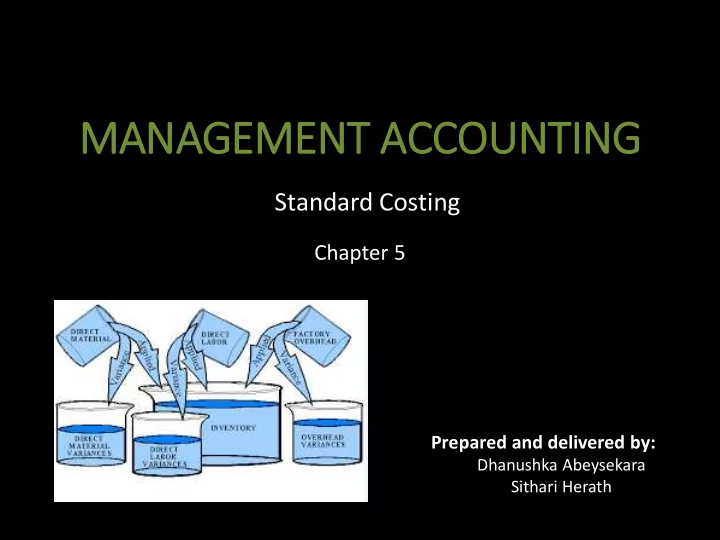

MANAGEMENT ACCOUNTING Standard Costing Chapter 5 Prepared and delivered by: Dhanushka Abeysekara Sithari Herath
What is a Standard cost? ‘Benchmark measurement of resource usage or revenue or profit generation, set in defined conditions’ . Or, ‘Control techniques that reports variances by comparing actual costs to preset standards, so facilitating actions through management by exception’ . The definition suggests four main areas Developing Standards: Before any control organization is required a specific/ preset plan which is known as present. Compare the standards with the actual (variance) Generate information (variance analysis) Make decision to improve performance (stimulate performance)
Key Concepts Single unit Vs Total aggregate Estimate in unit terms Standard Estimate in total terms Budget Quantity Vs Value As for standards by nature, mainly there are three types • Quantity/ volume standards • Rate/ price standards • Total standard If the organization is a manufacturing entity, prominent standards are likely to be materials/ labour/ OHs/ sales and under each type there will be price/rate standards or quantity volume standards.
When developing standards for price/rate organization can consider…. • Past prices • Estimates received from material or labour suppliers • Level of quality planned (e.g. high or low quality material, high or low skilled workers) • Agreements or possible agreements of trade unions • National legislations (e.g. minimum wage rate acts, price controls) • Type of overheads and the current methods used • Specific internal factors (competitors, customers e.g. level of demand, price elasticity and suppliers) • General external factors (PEST) When developing standards for quantity/volume organization can consider…. • Past performance • Competitor performance • Planned performance
Types of standards Depending on the planned level of difficulty there are few types of standards. Ideal Standard: Standards are set expecting perfect performance, with no allowance kept even for normal wastage. Attainable Standard: Standards are set keeping allowance for normal wastage/ achievable, yet challenging. Current Standard: Standards are set based on the current performance, with the purpose maintaining the current performance. Basic Standard: A standard kept unaltered for a long time.
Manufacturing Vs Service Organisations How to measure the unit standard? However, when there are several options (unit measures) a logical combination could be developed called “composite cot unit” How to develop a common standard? However, the processes/ inputs that are similar could be standardized. How to develop the same standard? However, less involvement of humans in the processes would help in developing a standard.
Developing an accurate standard is challenging? • Environment is dynamic • Not much labour involved • Need for continuous improvement • Analysis needed in more detail • How to motivate employees Comparing actual with standard (Variance) • The unit of comparisons are eventually converted into total terms (Total impact) • Wen converting into totality, actual activity level is used • Variances are normally delivered in value terms
Calculating variances Total variance general Formula (Standard cost per unit × Actual no. of units) – Actual cost Any price variance general Formula (Standard price per quantity – Actual price per quantity) × Actual quantity Any quantity variance general Formula (Standard quantity per unit × Actual no. of units – Actual quantity)× Standard price per quantity
Recommend
More recommend